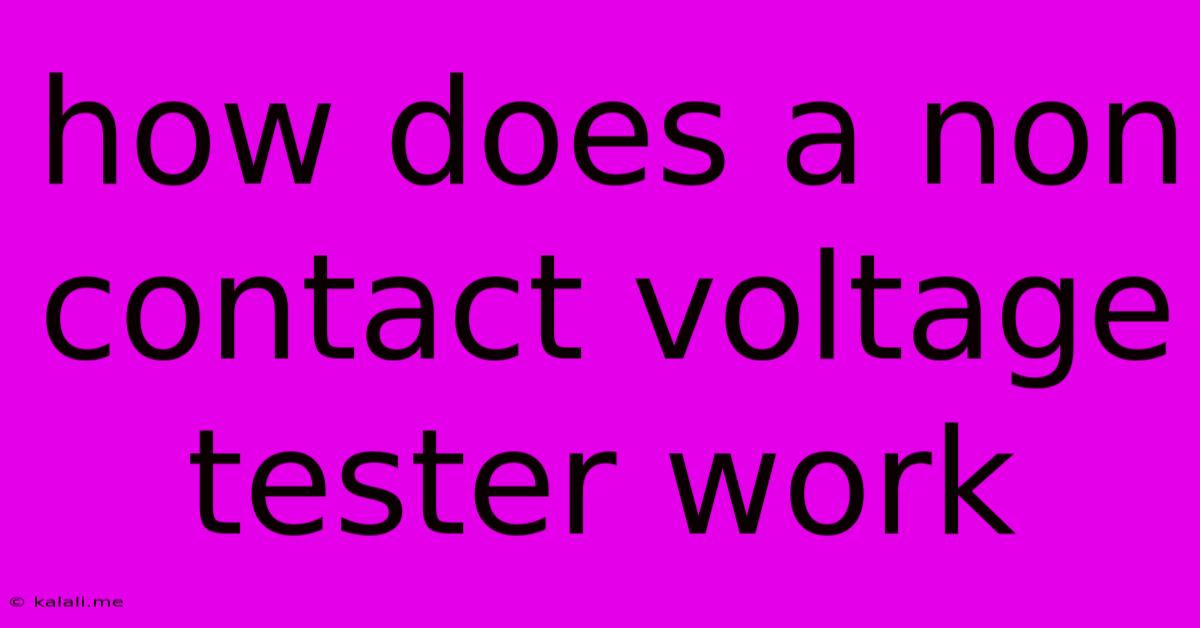How Does A Non Contact Voltage Tester Work
Kalali
May 31, 2025 · 3 min read

Table of Contents
How Does a Non-Contact Voltage Tester Work? A Deep Dive into Electrical Safety
This article explains the inner workings of a non-contact voltage tester (NCVT), a crucial tool for electricians and DIY enthusiasts alike. Understanding how these devices function enhances safety and allows for more effective use. We'll explore the technology behind their seemingly magical ability to detect voltage without physical contact.
What is a Non-Contact Voltage Tester?
A non-contact voltage tester, also known as a voltage sensor or voltage detector, is a hand-held device used to detect the presence of an alternating current (AC) voltage without needing to touch the wires or terminals directly. This minimizes the risk of electric shock, a significant advantage over traditional methods.
The Science Behind the Detection: Capacitive Coupling
The magic lies in capacitive coupling. The NCVT uses a highly sensitive circuit that detects the electric field surrounding a live conductor. This field is created by the voltage itself. The tip of the tester contains a small capacitor, essentially two conductive plates separated by an insulator.
When the tester is brought near a live conductor, the electric field induces a charge on the capacitor within the tester. This induced charge is then amplified and processed by the internal circuitry. If the voltage exceeds a certain threshold, the tester indicates the presence of voltage, usually through a visual signal (LED light) and/or an audible signal (beep).
Key Components and their Roles:
- Sensor: The tip of the tester houses the capacitor, which is the primary component responsible for sensing the electric field. The size and design of this capacitor influence the sensitivity and range of the tester.
- Amplifier: The weak signal received from the sensor is amplified to a level that can be processed by the microcontroller.
- Microcontroller: This tiny computer interprets the amplified signal, determines the voltage level, and controls the output signals.
- Indicator: The indicator (LED or buzzer) informs the user about the presence of voltage. Some advanced testers provide digital readings or even voltage ranges.
Factors Affecting NCVT Performance:
Several factors can influence the effectiveness of a non-contact voltage tester:
- Voltage Level: Lower voltages might be harder to detect, especially at longer distances.
- Distance: The closer the tester is to the live conductor, the stronger the detected signal. The effective range varies between models.
- Environmental Conditions: High humidity or electromagnetic interference can affect the accuracy of the readings.
- Tester Condition: A low battery or damaged sensor can lead to inaccurate or unreliable results.
Types of Non-Contact Voltage Testers:
While the underlying principle is similar, NCVTs come in various forms:
- Basic Testers: These usually indicate only the presence or absence of voltage.
- Advanced Testers: These provide more information, such as voltage range and phase detection.
Important Safety Precautions:
Even with a non-contact tester, it's crucial to observe safety precautions:
- Always treat any circuit as potentially live.
- Use caution around high voltage systems.
- Regularly check the tester's battery and functionality.
- Never rely solely on an NCVT for complete electrical safety. Always use appropriate personal protective equipment (PPE) when working with electricity.
Conclusion:
Non-contact voltage testers are invaluable tools for ensuring electrical safety. Understanding their inner workings – based on the principle of capacitive coupling and signal processing – allows for safer and more effective use. Remember that while these devices are a significant safety improvement, they are not a replacement for proper safety procedures and training. Always prioritize safety when dealing with electricity.
Latest Posts
Latest Posts
-
Computer Icons Drop Down Button For Email Icon
Jun 01, 2025
-
Wiring A Ceiling Fan With Two Switches
Jun 01, 2025
-
Skyrim Console Command To Show All Map Markers
Jun 01, 2025
-
Case When Is Not Null Sql
Jun 01, 2025
-
Can You Vent A Bathroom Fan Through A Soffit
Jun 01, 2025
Related Post
Thank you for visiting our website which covers about How Does A Non Contact Voltage Tester Work . We hope the information provided has been useful to you. Feel free to contact us if you have any questions or need further assistance. See you next time and don't miss to bookmark.